75+ Must-ask questions for your next workplace culture survey in 2024

Think back to 2011, when Netflix made the bold decision to split its DVD rental service from its streaming platform. The move led to confusion, public backlash, and an internal culture shift. Employees were left questioning the company’s direction, which quickly began impacting morale and performance.
Reed Hastings, Netflix’s CEO, realized the importance of understanding the company’s culture before making such drastic changes. By refocusing on transparency and employee feedback, Netflix was able to regain its footing and transform into the streaming giant we know today.
This situation highlights how a company's internal culture can make or break its success. Just like Netflix, any organization that doesn’t regularly assess its workplace culture risks losing employee alignment and productivity.
That’s where a workplace culture survey steps in — a tool to gauge how employees feel about the company's direction and ensure everyone is working towards the same goal.
Blog Highlights


What is an employee culture survey?

An employee culture survey is a tool designed to assess the core values, beliefs, and behaviors that shape an organization’s work environment. It goes beyond typical employee satisfaction surveys by focusing on how well employees align with the company’s mission, values, and leadership style.
These surveys evaluate key areas such as communication, leadership effectiveness, teamwork, and inclusivity. By collecting honest feedback, often anonymously, organizations can identify discrepancies between their intended culture and the actual experiences of their employees.
For instance, a company that promotes innovation might discover through the survey that employees feel restricted by rigid processes.
The data gathered helps leadership take actionable steps to close gaps, improve employee experience, and build a cohesive culture that promotes engagement and productivity. Employee culture surveys guide organizations in maintaining a healthy, values-driven workplace that aligns with their long-term goals.



It's about getting the best people, retaining them, nurturing a creative environment and helping to find a way to innovate.
Founder and CEO
Sunshine
Why is it important to improve company culture?
Improving company culture is crucial for several reasons. A positive company culture fosters a more productive and engaged workforce.
In today's competitive job market, skilled professionals seek out organizations that prioritize employee well-being, growth opportunities, and a positive culture.
A healthy company culture and employee wellbeing also play a crucial role in customer and employee satisfaction, and loyalty. When employees are happy and engaged, they deliver exceptional customer service, resulting in higher customer and employee satisfaction levels.
Lastly, a strong company culture contributes to the long-term success and sustainability of an organization. By investing in improving company culture, leaders create a strong foundation for growth and resilience.
What is a workplace culture survey?

A workplace culture survey is a tool designed to evaluate the environment within an organization by gathering employee feedback on key areas such as values, leadership, communication, and collaboration. It helps identify gaps between the company's intended culture and the actual experiences of its employees.
This type of survey measures how well employees align with the company’s core values, offering insights into areas where disconnects may exist. It also evaluates leadership effectiveness by collecting feedback on communication, decision-making, and support.
The survey assesses team dynamics, revealing how employees collaborate across departments. It focuses on employee well-being by addressing inclusivity, work-life balance, and overall satisfaction. By analyzing this data, organizations can take targeted actions to enhance workplace culture and boost employee engagement.
What is the purpose of a culture survey?
In the bustling realm of modern business, understanding your organization's culture isn't a luxury; it's a strategic necessity. That's where the culture survey comes into play, a powerful tool designed to uncover the core values, beliefs, and behaviors that shape your company.
But what's its purpose, you ask?
- Clarity amidst chaos: In today's diverse and dynamic workplaces, clarity is king. A Culture Survey helps bring order to the chaos, offering a bird's-eye view of the prevailing culture. It pinpoints the prevailing attitudes and shared norms that define your organization's identity.
- Strategic decision-making: Armed with insights from a culture survey, leaders can make informed decisions about strategy, recruitment, and employee development. It empowers organizations to course-correct, innovate, and adapt in a rapidly changing world.
- Enhancing performance: When employees feel aligned with the company culture, they tend to perform better, collaborate more effectively, and contribute to a healthier bottom line. A culture survey lays the foundation for boosting organizational performance.
What are the six major areas of cultural assessment?
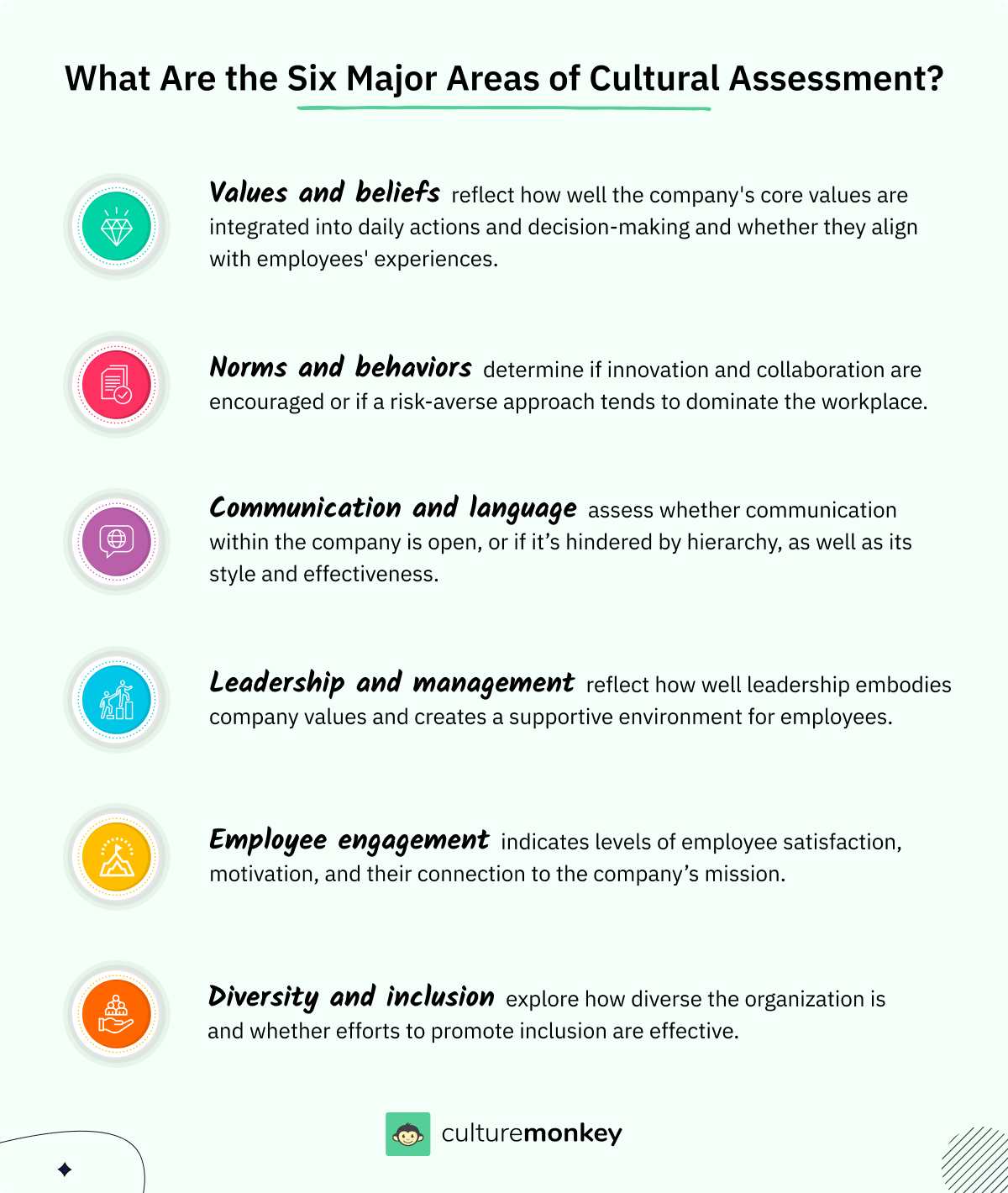
To understand and assess culture effectively, we need a structured approach. Enter the six major areas of cultural assessment, a roadmap that guides us through the intricate terrain of workplace culture.
- Values and beliefs: At the heart of every culture are its values and beliefs. What principles does your organization hold dear? Are they evident in daily operations and decision-making? A cultural assessment examines whether stated values align with lived experiences and whether they drive behavior within the company.
- Norms and behaviors: Culture isn't merely a set of ideals; it's a set of actions. This area delves into the unwritten rules and behaviors that govern the workplace. Are employees encouraged to innovate, take risks, or collaborate? Or does a more conservative, risk-averse approach prevail?
- Communication and language: How an organization communicates speaks volumes about its culture. A cultural assessment scrutinizes the communication channels, styles, and language used. Is communication open and transparent, or is there a hierarchical barrier that stifles the flow of information?
- Leadership and management: Leaders are torchbearers of culture. This area evaluates how leadership styles and practices align with the desired culture. Are leaders embodying the values and setting the right example? Are they approachable and supportive, or distant and authoritative?
- Employee engagement: An engaged workforce is often a reflection of a healthy culture. Assessing employee engagement involves gauging satisfaction, motivation, and commitment levels. Do employees feel connected to the company's mission? Are they enthusiastic about their work?
- Diversity and inclusion: In today's globalized world, diversity and inclusion are integral to culture. This area explores whether the organization is diverse in terms of demographics and perspectives. Are inclusion efforts tangible and effective, or is there room for improvement?
What is toxic culture in the workplace?
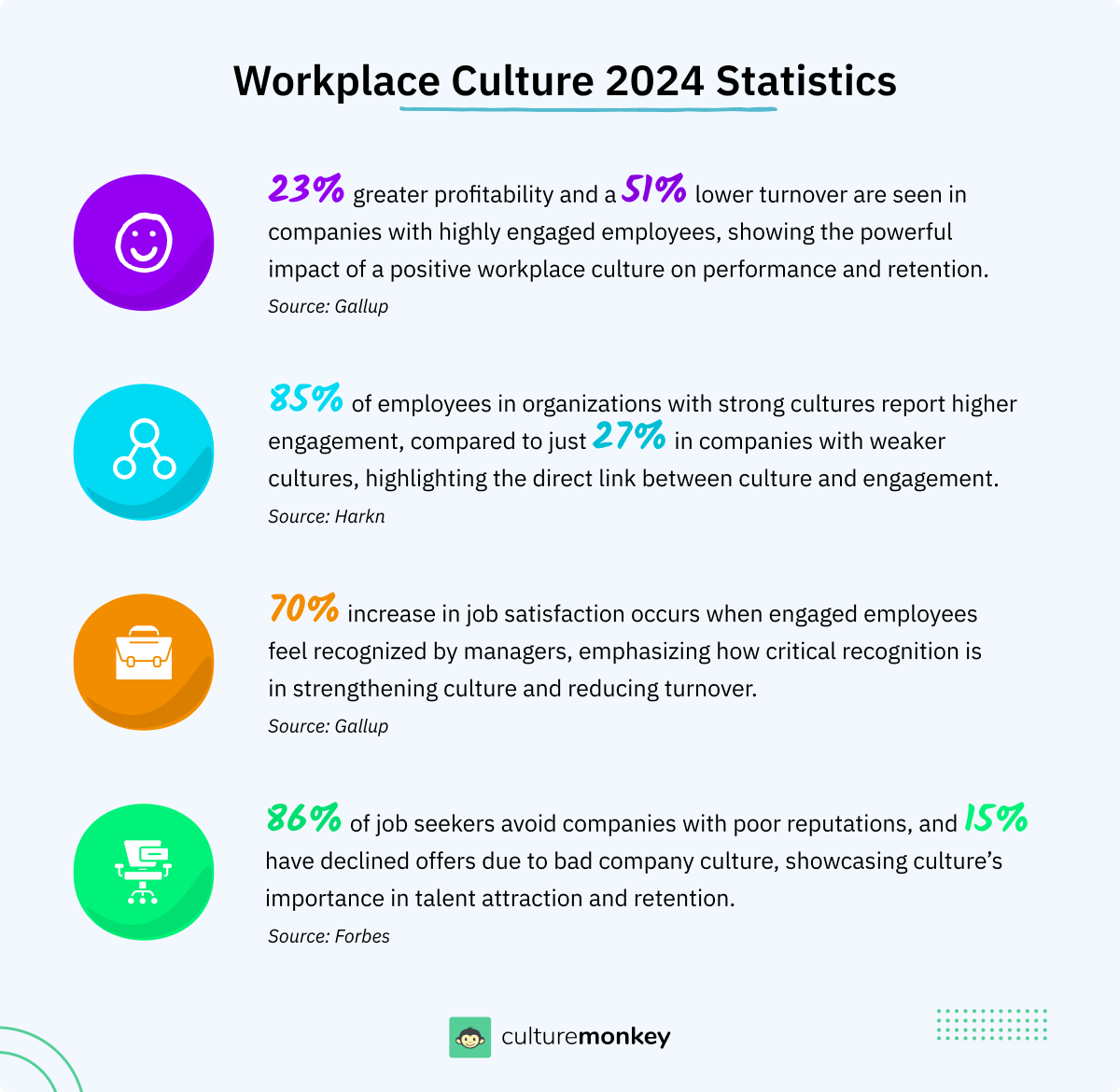
A toxic workplace culture is detrimental to both employees and the organization as a whole. It is characterized by behaviors, policies, and practices that undermine the health, well-being, and productivity of the workforce.
Understanding the signs and implications of a toxic culture is crucial for organizations aiming to foster a positive and productive work environment. Here are key aspects that define a toxic workplace culture:
- Lack of respect and inclusivity: Incidents of bullying, harassment, and discrimination are common, leading to an atmosphere of fear and mistrust. Diverse perspectives are neither valued nor encouraged, resulting in a lack of inclusivity and feelings of isolation among employees.
- Poor communication: Information is often unclear or withheld, creating confusion and misunderstanding. There is no constructive feedback, and open dialogue between employees and management is discouraged.
- Micromanagement and lack of autonomy: Employees are excessively monitored, leaving little room for independence or creativity. There is a pervasive lack of trust in employees' abilities, leading to low morale and job dissatisfaction.
- High levels of stress and burnout: Excessive workloads and unrealistic targets contribute to chronic stress and burnout. There is minimal support for maintaining a healthy work-life balance, with employees often expected to be available outside of regular working hours.
- Lack of recognition and reward: Employees' contributions and achievements are rarely recognized or rewarded. Career development opportunities are absent, leading to frustration and a lack of motivation.
- Office politics and favoritism: Decision-making is influenced by office politics and favoritism rather than merit and performance, creating an environment of unfairness and resentment. Favoritism breeds resentment and a sense of injustice among employees.
Benefits of conducting workplace culture survey

To truly understand the pulse of their workforce and drive meaningful change, more and more companies are turning to workplace culture surveys. Let’s discuss how they foster a thriving and inclusive work environment.
- Employee engagement and satisfaction: It acts as a powerful tool for gauging satisfaction levels. By providing employees with a platform to voice their opinions and concerns, organizations can demonstrate that they value their employees' perspectives.
- Identifying strengths and areas for improvement: Organizations gain valuable insights into their strengths and identify areas for improvement. The employee survey questions about culture provide a clear picture of what aspects of the organizational culture are working well and which ones may need attention.
- Enhancing communication and transparency: Workplace culture surveys catalyze open and transparent communication. They create an avenue for employees to share their thoughts and concerns, facilitating a dialogue between management and employees.
- Talent attraction and retention: Candidates actively seek out organizations that prioritize employee well-being and offer a positive work environment. According to a survey, almost 46% of job seekers prefer companies with a positive and nourishing work culture.
- Driving organizational growth and innovation: By understanding employee perspectives on areas such as collaboration, leadership, and career development, companies can implement targeted initiatives to fuel innovation and encourage cross-functional collaboration.
- Measuring the impact of culture initiatives: Workplace culture surveys serve as a means to evaluate the effectiveness of these initiatives. By comparing survey results over time, organizations can measure the impact of their efforts and make data-driven decisions to refine their strategies and create a positive work culture.
- Boosting employee morale and motivation: Regularly conducting these surveys and acting on the feedback can significantly boost employee morale and motivation. Employees feel valued and heard, leading to increased enthusiasm and commitment to their work.
- Supporting diversity and inclusion efforts: Surveys can highlight the state of diversity and inclusion within the organization. By addressing the issues and promoting inclusivity, companies can create a more equitable and supportive work environment for all employees.
Common challenges in conducting workplace culture surveys
Conducting workplace culture surveys is essential for understanding employee sentiments and improving organizational dynamics. However, there are several challenges that can arise during the process, affecting the accuracy and impact of the results. Here are some common challenges:
- Low participation rates: Employees may feel that their feedback won’t lead to real change, resulting in low participation. This can skew the results, making it difficult to gain a true representation of the workplace culture.
- Survey fatigue: Repeated surveys or overly long questionnaires can lead to survey fatigue, where employees become disengaged and respond superficially, thus limiting the depth and quality of feedback.
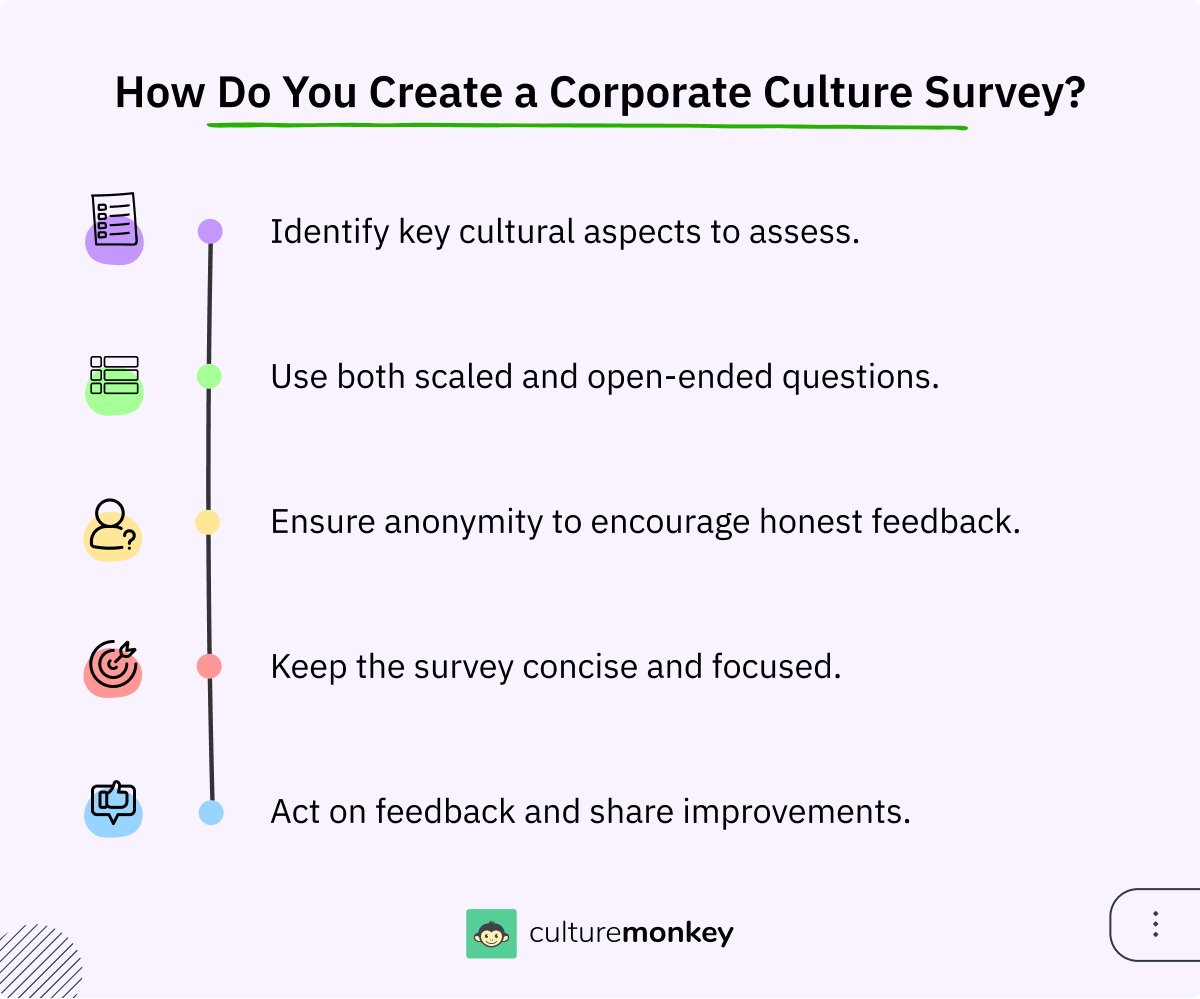
- Fear of repercussions: Even when surveys are anonymous, some employees may fear repercussions for sharing negative feedback. This fear can result in overly positive responses that do not accurately reflect the true culture.
- Unclear or biased questions: Poorly worded or leading questions can create biased responses, limiting the survey's effectiveness. It's important to ensure questions are clear, neutral, and aligned with the survey’s objectives.
- Inadequate follow-up: After gathering data, a lack of visible action on the feedback can demoralize employees and further reduce engagement in future surveys. Without follow-up, employees may lose trust in the process.
- Overgeneralized results: Aggregating data without accounting for departmental or demographic differences can obscure underlying issues specific to certain groups. Breaking down results by department or role ensures a more accurate understanding of culture-related problems.
What are the 4 aspects of corporate culture?

Corporate culture is the backbone of any organization, influencing how employees interact, make decisions, and contribute to the company's success. Understanding the four core aspects of corporate culture provides insight into how organizations operate and how they can improve.
- Values and beliefs: Values and beliefs form the foundation of corporate culture, guiding how decisions are made and influencing behavior across all levels. They often reflect the company’s mission and long-term objectives, creating a clear direction for employees to follow.
- Norms and behaviors: These are the unwritten rules that define how employees interact, collaborate, and communicate. Norms influence daily behaviors, from how meetings are conducted to how conflicts are resolved.
- Symbols and rituals: Corporate culture is also represented through symbols and rituals, such as logos, slogans, and company traditions that reinforce the organization’s identity and values. Celebrating achievements or holding annual events can enhance employees' sense of belonging and connection to the company.
- Communication and language: The way information is shared—through language, tone, and channels—significantly impacts corporate culture. Open and transparent communication fosters trust and inclusivity, while poor communication can lead to misunderstandings and disengagement.
How measuring employee engagement can help you improve workplace culture?
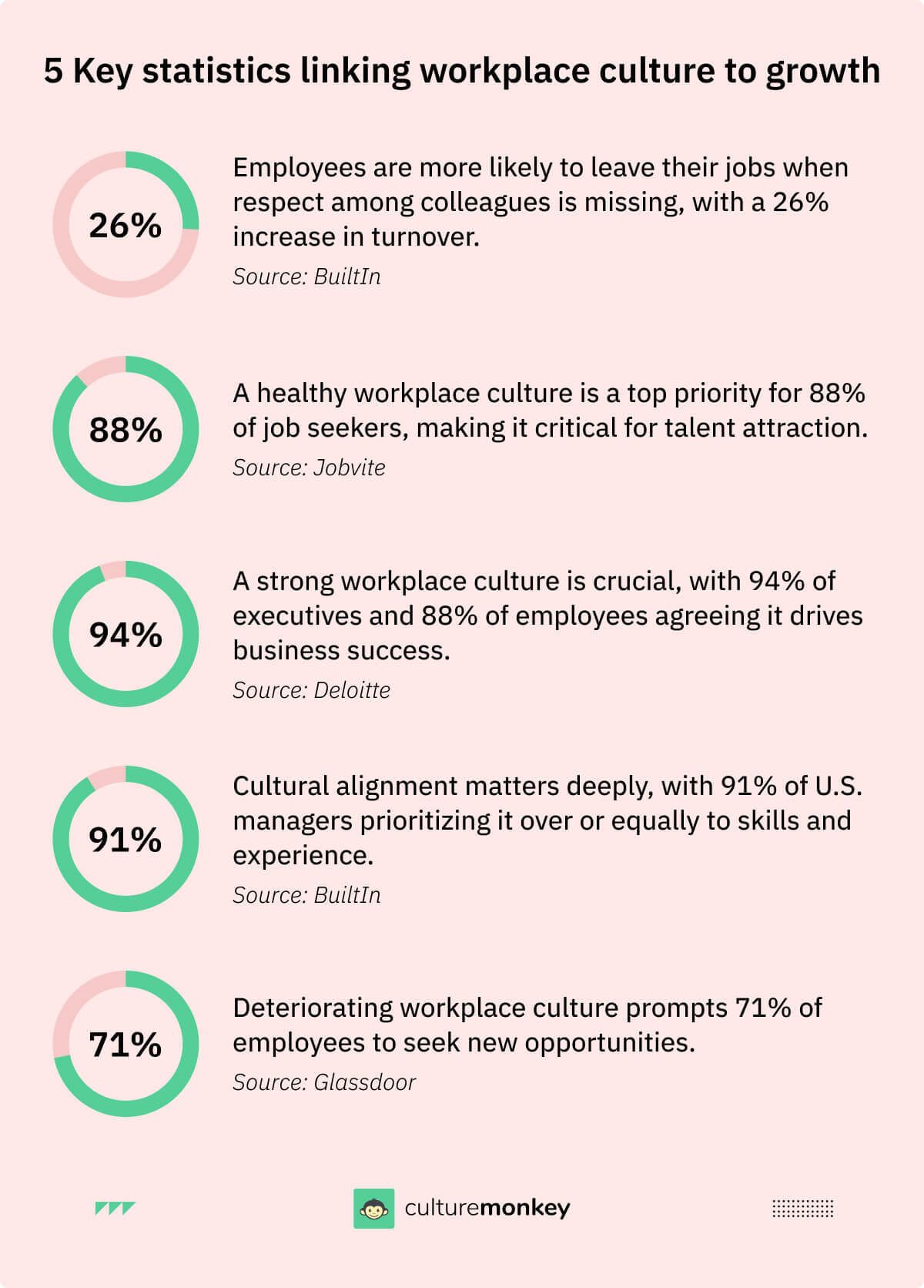
Measuring employee engagement is not just about collecting data; it's a powerful tool that can help organizations and employees thrive. Here's how measuring employee engagement can drive positive change and improve workplace culture:
- Identifying areas of improvement: Employee engagement surveys provide valuable insights into the strengths and weaknesses of the workplace culture. Organizations can pinpoint specific areas that need improvement like communication, recognition, or career development.
- Fostering open communication: Measuring employee engagement encourages open and transparent communication. When employees are allowed to share their opinions, concerns, and suggestions through surveys or feedback mechanisms, it creates a culture of listening and responsiveness.
- Driving employee empowerment: Engaged employees feel a sense of empowerment and ownership in their work. By understanding what drives employee engagement, organizations can design programs and initiatives that empower employees, enabling them to take ownership of their work and contribute to a positive and inclusive company culture.
- Enhancing employee well-being: Engagement surveys often include questions related to employee work-life balance and stress levels.
- Strengthening leadership and management: Measuring employee engagement provides insights into the effectiveness of leadership and management practices. It highlights areas where leaders may need additional support or development.
- Promoting continuous improvement: Regularly measuring employee engagement allows organizations to track employee well-being and progress over time and evaluate the positive impact of culture-building initiatives.
How do you create a corporate culture survey?

Creating a corporate culture survey involves careful planning and consideration to ensure the survey effectively captures the desired information. Here are the key steps to create a corporate workplace culture survey question:
- Define the objectives: Determine what specific aspects of the corporate culture you want to assess, such as employee engagement, communication, leadership, diversity, inclusion, or work-life balance.
- Select the survey format: Decide on the format that best suits your organization's needs. Online surveys are often more convenient, and cost-effective, and provide efficient data collection and analysis capabilities. Choose a user-friendly survey platform that allows customization and easy distribution to the target audience.
- Design the survey questions: Ensure that the questions are clear, concise, and relevant to the objectives of the survey. Use a combination of closed-ended (multiple-choice, Likert scale) and open-ended questions to gather both quantitative and qualitative data.
- Pilot test the survey: Before distributing the survey organization-wide, conduct a pilot test with a small group of employees. This helps identify any issues with the survey design, question clarity, or response options.
- Determine timing and frequency: Decide on the timing and frequency of your corporate culture survey. Will it be an annual, biannual, or quarterly assessment? Establishing a consistent schedule ensures that you can track changes over time.
- Engage stakeholders: Involve key stakeholders, such as HR professionals, department heads, and employee representatives, in the survey creation process. Their input can help ensure that the survey aligns with organizational goals and addresses specific departmental or employee concerns.



A company's culture is the foundation for future innovation. An entrepreneur's job is to build the foundation.
CEO
Airbnb
- Anonymity and confidentiality: Clearly communicate the level of anonymity and confidentiality that participants can expect. Assure employees that their responses will be kept confidential to encourage honest and candid feedback.
- Data analysis and action planning: Prepare a plan for analyzing survey results and translating them into actionable initiatives. Identify responsible parties for addressing specific issues or implementing improvements based on the feedback received.
- Analyze and act on the results: Once the survey responses are gathered, it's crucial to analyze the data carefully. Look for patterns, trends, and areas of concern within the results. From there, develop actionable plans to address any issues or areas for improvement that arise.
- Foster a culture of transparency and accountability: Transparency about the survey results demonstrates a commitment to listening and acting on feedback. Additionally, hold leaders and teams accountable for implementing changes and improvements based on the survey findings. Encourage ongoing dialogue and updates to keep employees informed about progress and next steps.
How to choose effective company culture survey questions
Choosing effective company and business culture survey questions is essential for gaining accurate insights into how employees perceive and experience the workplace. Well-crafted questions can uncover hidden issues and highlight areas for improvement. Here are key considerations when selecting survey questions:
- Align with company values: Survey questions should reflect the core values and mission of the organization. This ensures that you are assessing whether the company culture aligns with its stated goals and principles.
- Use open-ended questions for depth: Including open-ended questions allows employees to share their thoughts in more detail. These questions can reveal underlying concerns or opportunities that may not be captured in closed-ended questions.
- Avoid leading questions: Questions should be neutral and unbiased to encourage honest responses. Leading questions can skew results, giving a false sense of employee satisfaction or dissatisfaction.
- Incorporate questions on inclusivity and belonging: It's essential to understand how diverse groups within the organization experience the culture. Asking questions about inclusivity and whether employees feel a sense of belonging can provide critical insights into the overall health of the workplace culture.
- Balance between quantitative and qualitative: A good culture survey includes both types of questions—quantitative questions that can be easily measured, like Likert scale questions, and qualitative questions that capture the 'why' behind employee responses.
- Focus on actionable insights: Ensure the questions are designed to provide actionable feedback. For example, instead of broad questions, ask specifics like, “Do you feel supported by leadership when you raise concerns?”
What does a good company culture look like?

Good company culture is characterized by several key elements that create a positive and engaging work environment.
- Clear vision and values: A good company culture is built on strong core values that define the organization's beliefs and principles. These values are not merely words on a wall but are actively practiced and integrated into the daily operations and decision-making processes.
- Open and transparent communication: There is an emphasis on clear and effective communication channels that enable employees to share ideas, concerns, and feedback.
- Respect and inclusivity: A study by the Statista Research Department, highlighted how almost 72% of Americans preferred working in a diverse environment. Thus a good work culture should consist of a diverse workforce and actively promotes equity and inclusion.
- Supportive leadership: Leaders inspire and motivate employees, providing guidance and support to help them reach their full potential. They lead by example, embodying the organization's values and fostering a positive work environment.
- Employee development and growth: It provides opportunities for learning, training, and advancement, allowing employees to continually develop their skills and knowledge.
- Collaboration and teamwork: The organization promotes a culture of cross-functional teamwork, where employees are encouraged to work together, share ideas, and collaborate on projects.
- Recognition and rewards: There are mechanisms in place to acknowledge and appreciate employee efforts, whether through formal recognition programs, or performance-based incentives.
- Work-life balance: The organization encourages employees to prioritize self-care and maintain a healthy work-life balance between work and personal life.
- Social responsibility: The organization actively participates in philanthropic initiatives, environmental sustainability efforts, and community engagement.
- Continuous improvement: The organization values learning from mistakes and encourages a growth mindset that embraces new ideas and approaches.
What is culture questionnaire?
Picture this: Your company's culture is like the DNA of your organization, influencing everything from employee morale to customer satisfaction. But how can you pinpoint its essence? That's where this questionnaire comes in.
The "What is Culture Questionnaire" is your treasure map to the soul of your company. It's not your average survey; it's a deep dive into the values, beliefs, and behaviors that make your organization unique. By asking thought-provoking company culture survey questions, it unveils the hidden gems of your culture.
Imagine discovering that your company's culture thrives on innovation and risk-taking. Or perhaps it's rooted in tradition and stability. Maybe it's a blend of both! Whatever the case, this questionnaire will reveal it all.
But it's not just about understanding your culture; it's about shaping it. Armed with the insights from this questionnaire, you can align your company's values with its actions, fostering a more harmonious and productive work environment.
Top 75+ workplace culture survey questions

- How would you rate the clarity of the organization's vision and mission?
- On a scale of 1 to 10, how well do you feel your work aligns with the organization's goals?
- Do you believe your contributions are recognized and appreciated within the organization?
- How would you rate the overall communication within the organization?
- Are you satisfied with the level of transparency in decision-making processes?
- Do you feel comfortable expressing your opinions and ideas in the workplace?
- On a scale of 1 to 10, how would you rate the level of teamwork and collaboration in your department?
- How satisfied are you with the opportunities for growth and career development within the organization?
- Do you feel your skills and expertise are utilized effectively in your current role?
- How supported do you feel by your immediate supervisor or manager?
- Do you believe the organization values and promotes diversity and inclusion?
- How well does the organization support work-life balance for its employees?
- On a scale of 1 to 10, how satisfied are you with the organization's efforts in employee well-being and employee support programs?
- How well does the organization promote a positive and inclusive work environment?
- How would you rate the organization's recognition and rewards programs?
- How comfortable do you feel sharing concerns or raising issues without fear of negative consequences?
- On a scale of 1 to 10, how likely are you to recommend this organization as a great place to work?
- How well does the organization support remote work and flexible scheduling options to accommodate your needs?
- On a scale of 1 to 10, how effective is the onboarding process for new employees in helping them assimilate into the company culture?
- Do you feel that the organization fosters a sense of innovation and encourages employees to contribute creative ideas?
- How well does the organization handle conflict resolution and address interpersonal issues among employees?
- On a scale of 1 to 10, how well does the organization provide opportunities for skill development and continuous learning?
- Are you satisfied with the level of recognition and feedback provided for your performance on a regular basis?
- How would you rate the organization's commitment to sustainability and corporate social responsibility initiatives?
- Do you feel the organization promotes a healthy work-life integration, including policies for mental health and well-being support?
- On a scale of 1 to 10, how effective are the diversity and inclusion training programs offered by the organization?
- Are you aware of and comfortable with the organization's ethics and compliance policies and reporting mechanisms?
- How well does the organization respond to and address concerns related to workplace diversity, equity, and inclusion?
- On a scale of 1 to 10, how satisfied are you with the organization's efforts to create a safe and harassment-free workplace environment?
- Do you feel that the organization's leadership exemplifies the values and behaviors it expects from employees?
- How well does the organization support employees in times of personal or family emergencies?
- On a scale of 1 to 10, how effective are the organization's efforts in promoting cross-cultural understanding and awareness among employees?
- How well does the organization support employees in times of personal or family emergencies?
- On a scale of 1 to 10, how effective are the organization's efforts in promoting cross-cultural understanding and awareness among employees?
- How would you rate the effectiveness of the organization's communication channels in keeping employees informed about important updates and changes?
- On a scale of 1 to 10, how would you rate the level of autonomy and decision-making authority you have in your role?
- Are you satisfied with the accessibility and responsiveness of the organization's HR department in addressing employee concerns and inquiries?
- How well does the organization encourage and facilitate knowledge-sharing and collaboration among different departments or teams?
- On a scale of 1 to 10, how supported do you feel in maintaining a healthy work-life balance by your direct supervisor or manager?
- How well does the organization provide resources and support for professional development and continuing education?
- Do you feel that the company effectively addresses employee suggestions and implements feasible ideas?
- On a scale of 1 to 10, how satisfied are you with the technological tools and resources available to perform your job effectively?
- How well does the organization foster a culture of respect and integrity?
- Are you satisfied with the organization’s efforts to recognize and celebrate diversity-related events and milestones?
- On a scale of 1 to 10, how effective are the company's mental health resources and support systems?
- Do you feel that the organization provides adequate opportunities for social interaction and team-building activities?
- How well does the organization ensure that employees' workloads are manageable and realistic?
- On a scale of 1 to 10, how effective are the organization's initiatives in supporting community engagement and volunteerism?
- Are you satisfied with the transparency and communication regarding the organization's strategic goals and plans?
- How well does the organization provide feedback and performance reviews that help you grow professionally?
- Do you feel the organization’s policies and procedures are fair and consistently applied?
- On a scale of 1 to 10, how would you rate the overall morale and job satisfaction among your colleagues?
- Are you satisfied with the organization’s initiatives to ensure employee physical health and safety?
- On a scale of 1 to 10, how effectively does the organization implement changes based on employee feedback?
- On a scale of 1 to 10, how effective are the organization's efforts in fostering employee engagement?
- Do you feel that the organization provides clear expectations and goals for your role?
- How well does the organization promote a sense of belonging among employees?
- Are you satisfied with the organization's approach to managing remote and hybrid work arrangements?
- On a scale of 1 to 10, how would you rate the fairness and transparency of the organization's compensation and benefits packages?
- How effectively does the organization recognize and address employee burnout?
- Do you believe the organization provides sufficient opportunities for employees to give feedback regularly?
- How well does the organization handle career advancement and promotion processes?
- On a scale of 1 to 10, how comfortable are you with the organization's work-from-home policies and practices?
- Do you feel that the organization's decision-making process is inclusive of diverse perspectives?
- How satisfied are you with the organization's approach to handling work-related stress and pressure?
- On a scale of 1 to 10, how would you rate the organization's adaptability to change and innovation?
- Are you satisfied with the tools and resources provided for virtual collaboration and teamwork?
- Do you believe the organization offers fair and equal opportunities for professional growth, regardless of background?
- How well does the organization provide mentorship or coaching programs to support your career development?
- How effectively does the organization promote transparency in internal communications regarding changes in leadership or strategy?
- Do you feel the organization actively seeks to innovate and improve its processes?
- On a scale of 1 to 10, how well does the organization foster a sense of accountability and ownership among employees?
- Are you satisfied with the frequency and clarity of updates regarding organizational changes and future plans?
- How well does the organization support mentorship and peer-learning opportunities across different departments?
- Do you feel the organization’s conflict resolution processes are fair and effective?
- On a scale of 1 to 10, how effective is the organization in creating an inclusive environment where all employees feel heard and valued?
- How satisfied are you with the organization’s efforts to create a strong, supportive company culture that aligns with its values?
How can you use company culture survey results?
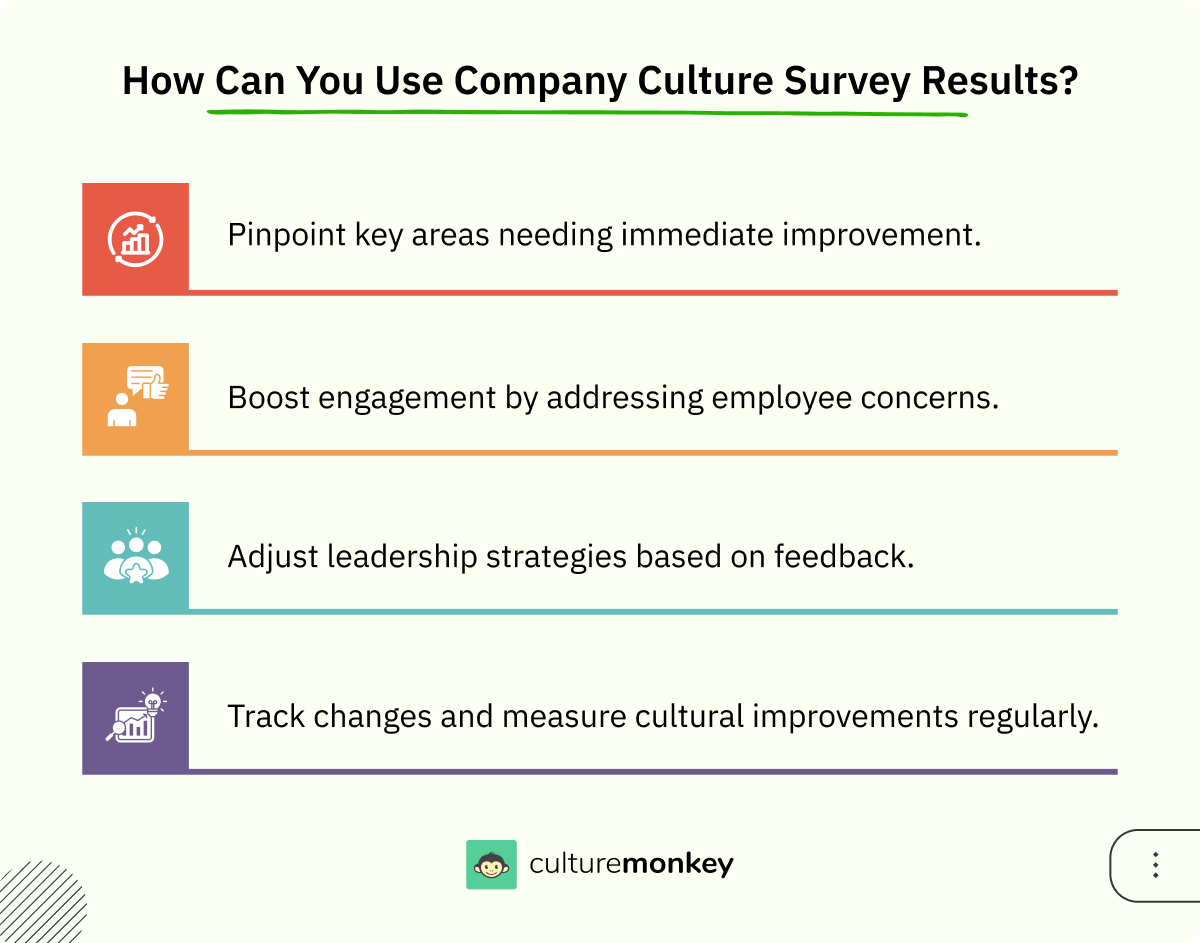
Company culture survey results offer valuable insights into the perceptions, experiences, and sentiments of employees within an organization.
Let's explore some ways in which companies can leverage these survey results to drive positive change and enhance organizational effectiveness.
- Identify strengths and weaknesses: Company culture survey results provide valuable insights into the strengths and weaknesses of your organization's culture. Analyze the data to identify areas where the company excels and where improvements are needed. This understanding is essential for fostering a positive work environment and addressing any underlying issues.
- Inform strategic decision-making: Use survey results to inform strategic decision-making processes. For example, if the survey reveals a lack of communication or collaboration among teams, consider implementing initiatives to improve communication channels or team-building activities. Aligning strategic decisions with survey findings ensures that organizational changes are targeted and effective.
- Drive employee engagement: Employee engagement is closely linked to company culture. Survey results can help identify factors that contribute to employee engagement, such as recognition programs, professional development opportunities, or work-life balance initiatives. By addressing these factors, you can boost employee morale, productivity, and retention rates.
- Enhance leadership effectiveness: Assessing leadership effectiveness is a crucial aspect of company culture surveys. Evaluate feedback on leadership styles, communication skills, and employee satisfaction with management. Use this information to provide targeted leadership training and development programs to enhance managerial skills and foster a positive leadership culture.
- Promote diversity and inclusion: Company culture surveys can shed light on the organization's diversity and inclusion efforts. Analyze survey data to assess the inclusivity of policies, practices, and workplace environments. Take proactive steps to promote diversity and inclusion, such as implementing diversity training programs, establishing diversity committees, and fostering a culture of respect and belonging for all employees.
- Monitor progress over time: Continuously monitor company culture survey results over time to track progress and identify trends. Regularly assessing the effectiveness of cultural initiatives allows you to make adjustments as needed and ensure ongoing improvement. By monitoring progress over time, you can demonstrate a commitment to cultivating a positive and inclusive work culture.
- Communicate findings and take action: Finally, communicate survey findings transparently with employees and stakeholders. Share insights from the survey and outline actionable steps that will be taken based on the feedback received. Encourage open dialogue and collaboration to ensure that employees feel heard and valued in the process of shaping the company's culture.
Work culture survey vs. employee engagement survey
A work culture survey and an employee engagement survey are two different types of employee surveys that focus on different aspects of the workplace. Here's how they differ:
Work culture survey
It assesses the overall culture, values, and norms within an organization. The aim of this is to identify the areas that need improvement, and alignment with the organization's mission and values.
The questions in a work culture survey may cover topics such as communication, collaboration, leadership, diversity and inclusion, work-life balance, and organizational values.
Employee engagement survey
It measures the level of engagement and commitment of employees within the organization. The focus is on factors such as job satisfaction, motivation, loyalty, productivity, and intention to stay with the organization.
These surveys often include questions related to the employee's relationship with their immediate supervisor, opportunities for growth and development, recognition and rewards, work-life balance, and the overall work environment.
How do you measure culture survey?
Culture, often intangible and ever-evolving, is the soul of an organization. Measuring it might seem like trying to capture the wind, but with the right approach, you can gauge the pulse of your culture survey effectively. Here's how:
- Customized surveys: Begin by designing culture-specific surveys tailored to your organization's unique values and goals. These surveys should encompass various aspects of culture, including values, behaviors, communication, and leadership.
- Clear objectives: Define what you want to achieve with the culture survey. Are you assessing alignment with company values, identifying areas for improvement, or measuring the impact of recent culture initiatives? Setting clear objectives will guide your measurement efforts.
- Quantitative data: Use quantitative questions with Likert scales to gather numerical data. These questions can help you assess the prevalence of specific cultural attributes and trends over time.
- Qualitative insights: Supplement quantitative data with open-ended questions. These allow employees to share their thoughts, experiences, and suggestions, providing rich qualitative insights into the culture.
- Regular pulse checks: Conduct culture surveys regularly, whether annually, biannually, or quarterly. Consistency allows you to track trends, identify changes, and measure the effectiveness of culture-related initiatives.
- Comparative analysis: Compare survey results over time to identify shifts or patterns. Look for correlations between cultural factors and key performance indicators (KPIs) like employee turnover, customer satisfaction, and profitability.
- Employee feedback: Act on the insights gathered. Engage in dialogue with employees about the survey results and involve them in co-creating solutions to address identified issues or reinforce positive aspects of the culture.
- Continuous improvement: Treat culture measurement as an ongoing process. Continuously refine your surveys based on feedback, industry best practices, and changing organizational needs.
- External benchmarks: Benchmark your culture against industry peers or organizations known for their strong cultures. This external perspective can provide valuable context.
- Technology tools: Utilize advanced survey and data analysis tools to streamline the measurement process, automate data collection, and generate actionable insights.
How to analyze workplace culture survey results

Analyzing workplace culture survey results is crucial for turning feedback into actionable insights. Proper analysis helps leaders understand employee perceptions and identify areas for improvement. Here’s how to effectively analyze the results:
- Segment the data: Break down the results by departments, teams, and demographics to identify specific cultural issues within different groups. This helps in addressing problems more precisely rather than making broad assumptions based on overall data.
- Identify patterns and trends: Look for recurring themes in the feedback, such as communication gaps or issues with leadership. Identifying patterns helps to pinpoint systemic cultural challenges that need to be addressed at the organizational level.
- Compare with industry benchmarks: Benchmarking your results against industry standards or previous survey data provides context. It helps to see whether the company’s culture is improving or lagging behind competitors, offering valuable insights for growth.
- Focus on key metrics
Metrics such as employee satisfaction, alignment with company values, and engagement levels should be given special attention. Highlighting these metrics allows you to track progress on the most critical areas of workplace culture. - Assess open-ended responses: Analyze qualitative feedback from open-ended questions for more nuanced insights. This type of feedback often highlights specific challenges that may not be captured in quantitative data.
- Prioritize actionable insights: Focus on the insights that can lead to meaningful change. Create a clear action plan based on the areas needing immediate attention, and communicate these plans with employees to build trust.
Other ways leaders & HR can gauge company culture

Leaders and HR professionals have various ways to assess company culture beyond traditional surveys. Understanding the true dynamics of an organization’s culture requires diverse approaches that provide both quantitative and qualitative insights. Here are some additional methods:
- Exit interviews: Analyzing feedback from employees who are leaving the organization can provide valuable insights into potential cultural issues that may not be immediately visible to current employees. Exit interviews often reveal honest perspectives on the work environment, leadership, and areas of dissatisfaction.
- Feedback channels: Establishing open feedback channels, such as anonymous suggestion boxes or digital feedback platforms, allows employees to express their thoughts on the culture continuously. This enables leadership to monitor cultural trends in real-time.
- Internal social networks: Observing interactions on internal social networks or communication platforms like Slack or Microsoft Teams can give insight into the level of engagement, collaboration, and overall tone of workplace interactions.
- Culture audits: HR teams can conduct culture audits by reviewing policies, practices, and employee experiences. This involves looking at how well the company’s stated values align with day-to-day operations and employee behavior.
- Manager feedback: Gathering feedback from managers can provide a different perspective on culture. Managers often act as a bridge between leadership and employees, offering insights into how cultural initiatives are received and executed across various teams.
What are some signs that it may be time for an organization to conduct a culture survey?
By identifying key indicators and signs that prompt the need for a culture survey, organizations can proactively address challenges and cultivate a culture that aligns with their values and objectives.
- Decreased employee morale: A noticeable decline in employee morale can be an indicator of underlying issues within the organizational culture. If employees seem disengaged, demotivated, or dissatisfied, it may be time to conduct a culture survey to identify the root causes of their discontent.
- High turnover rates: A sudden increase in turnover rates or difficulty retaining top talent could signal cultural challenges within the organization. Conducting a culture survey can help uncover factors contributing to employee turnover, such as lack of career development opportunities, poor leadership, or a toxic work environment.
- Communication breakdowns: Persistent communication breakdowns or misalignment between teams or departments may indicate a need to assess the organization's communication practices and overall cultural climate. A culture survey can identify communication barriers and help implement strategies to improve collaboration and transparency.
- Stagnant innovation: If the organization is experiencing a lack of innovation or creativity, it may be a sign that the current culture is hindering employees' ability to think creatively and take risks. Conducting a culture survey can reveal barriers to innovation, such as fear of failure or resistance to change, and enable the organization to foster a more innovative culture.
- Increased conflict or tension: Rising levels of conflict or tension among employees or between departments may indicate underlying cultural issues, such as lack of trust, poor conflict resolution skills, or unhealthy competition. A culture survey can identify sources of conflict and help implement strategies to promote collaboration, respect, and teamwork.
- Poor performance or productivity: Declines in organizational performance or productivity could be linked to cultural factors such as low employee engagement, ineffective leadership, or unclear goals and expectations. Conducting a culture survey can uncover barriers to performance and enable the organization to implement initiatives that enhance productivity and drive results.
- Lack of alignment with organizational values: If there is a disconnect between the organization's stated values and the actual behaviors and practices exhibited in the workplace, it may be time to reassess the organizational culture. A culture survey can gauge employees' perceptions of the company's values and help align cultural norms with organizational goals and objectives.
Examples of innovative workplace culture initiatives
Innovative workplace culture initiatives play a pivotal role in shaping organizations that thrive on creativity, engagement, and inclusivity. These initiatives not only enhance employee satisfaction but also foster a positive company culture, aligning the workforce with organizational goals. Below are three examples of companies that have implemented groundbreaking workplace culture initiatives.
Google – Fostering creativity through 20% time
Google’s renowned “20% time” initiative allows employees to dedicate 20% of their work hours to projects outside their core responsibilities. This policy encourages creativity and innovation, empowering employees to explore their passions and develop groundbreaking ideas. Iconic projects like Gmail and Google Maps were born from this initiative, showcasing how fostering creative freedom can lead to transformative success.
Adobe – Encouraging intrapreneurship with Kickbox
Adobe's Kickbox program equips employees with a red box containing a pre-paid credit card, tools, and resources to experiment with innovative ideas. The initiative promotes intrapreneurship, empowering employees to test their concepts without the fear of failure. By giving employees autonomy and support to innovate, Adobe creates a culture of trust and continuous improvement that drives both personal and organizational growth.
Patagonia – Championing environmental responsibility
Patagonia integrates environmental activism into its workplace culture by encouraging employees to participate in ecological initiatives. The company offers paid time off for employees to engage in environmental conservation and supports grassroots movements. This commitment to sustainability not only resonates with employees but also reinforces Patagonia’s mission-driven ethos, fostering loyalty and shared purpose.
5 Best culture assessment tools in 2024
1. CultureMonkey
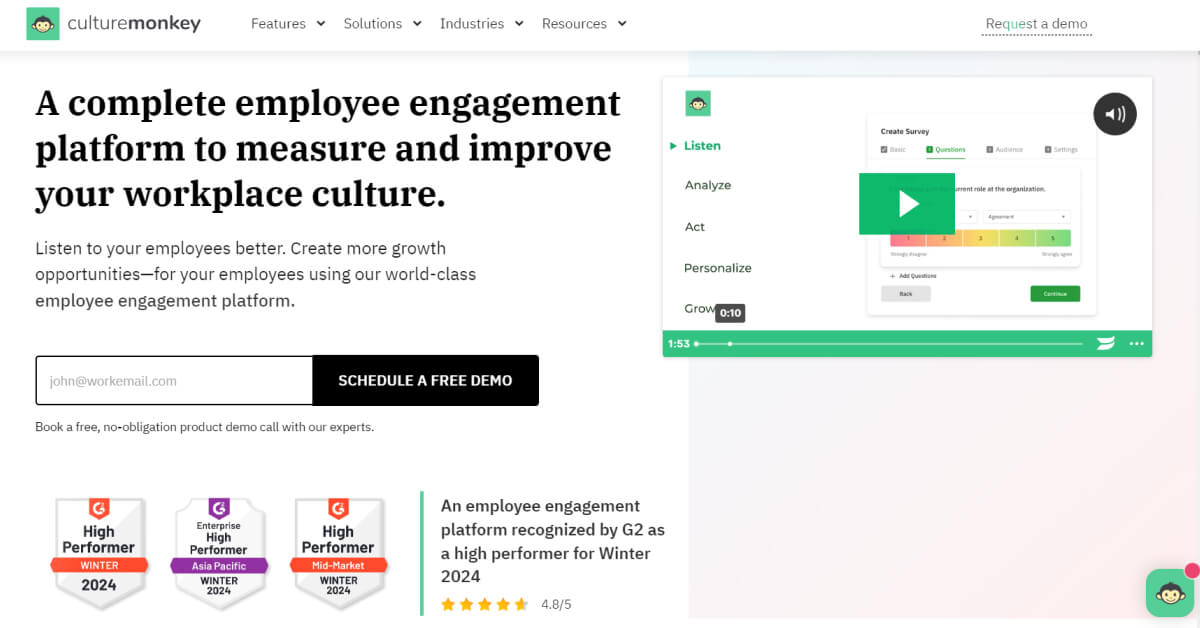
CultureMonkey is a cutting-edge employee pulse survey software that revolutionizes the way organizations assess and improve their workplace culture and employee engagement. Here's an overview of the key features and benefits offered by CultureMonkey:
- User-friendly interface: CultureMonkey boasts an intuitive interface that empowers organizations to effortlessly create and deploy employee pulse surveys. This ease of use encourages higher participation rates and ensures that feedback is collected efficiently.
- Personalized surveys: With CultureMonkey, organizations can tailor their surveys by adding personalized questions related to specific employee engagement drivers, allowing for a more comprehensive assessment of their culture.
- Diverse pulse survey templates: CultureMonkey provides access to a vast library of over 100 research-backed pulse survey templates. These templates serve as a launchpad for organizations looking to kickstart their feedback collection process.
- Seamless integration: CultureMonkey integrates seamlessly with leading HRMS tools like Darwinbox, Zoho People, Okta, and Keka, offering a comprehensive employee feedback experience. This integration streamlines data collection and analysis.
- Multilingual surveys: The platform accommodates multilingual survey questions, ensuring that all employees, regardless of their background, can conveniently provide feedback.
- Social and professional integration: CultureMonkey extends its reach by integrating with popular communication channels like Slack, Teams, and WhatsApp. This integration boosts participation rates and encourages open communication.
- Anonymous conversations: CultureMonkey encourages open and honest dialogue between employees and management by transforming anonymous feedback into anonymous conversations. This promotes transparency and trust within the organization.
- Comprehensive reporting: The platform offers an engagement score heat map, industry benchmark comparisons, and customizable survey reports. These features enable organizations to measure the most critical employee engagement metrics and identify areas for improvement.
Learn more about CultureMonkey
2. Culture Amp
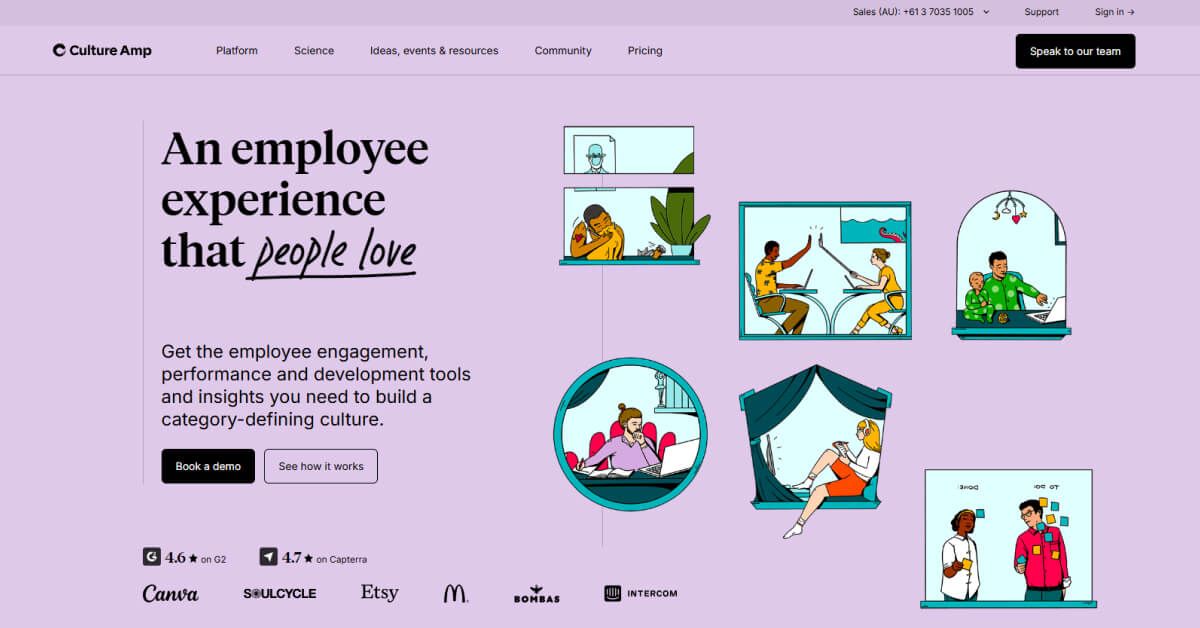
- Tailored insights: Culture Amp offers the flexibility to craft customized surveys that align with your unique organizational goals. From measuring employee engagement to gauging the impact of culture initiatives, this tool delivers tailored insights that drive actionable change.
- Seamless integration: Embracing the digital age, Culture Amp seamlessly integrates with various HR systems, ensuring a smooth flow of data. It empowers organizations to leverage existing tech stacks for a comprehensive culture assessment.
- Advanced analytics: Unlock the power of data with Culture Amp's advanced analytics. Dive deep into the nuances of your culture, and with industry benchmarks, gain the competitive edge by identifying strengths and areas for improvement.
- Actionable feedback: Beyond data collection, Culture Amp focuses on driving meaningful change. It transforms feedback into action plans, ensuring that organizations not only measure culture but actively shape it for a brighter, more engaged future.
3. Officevibe
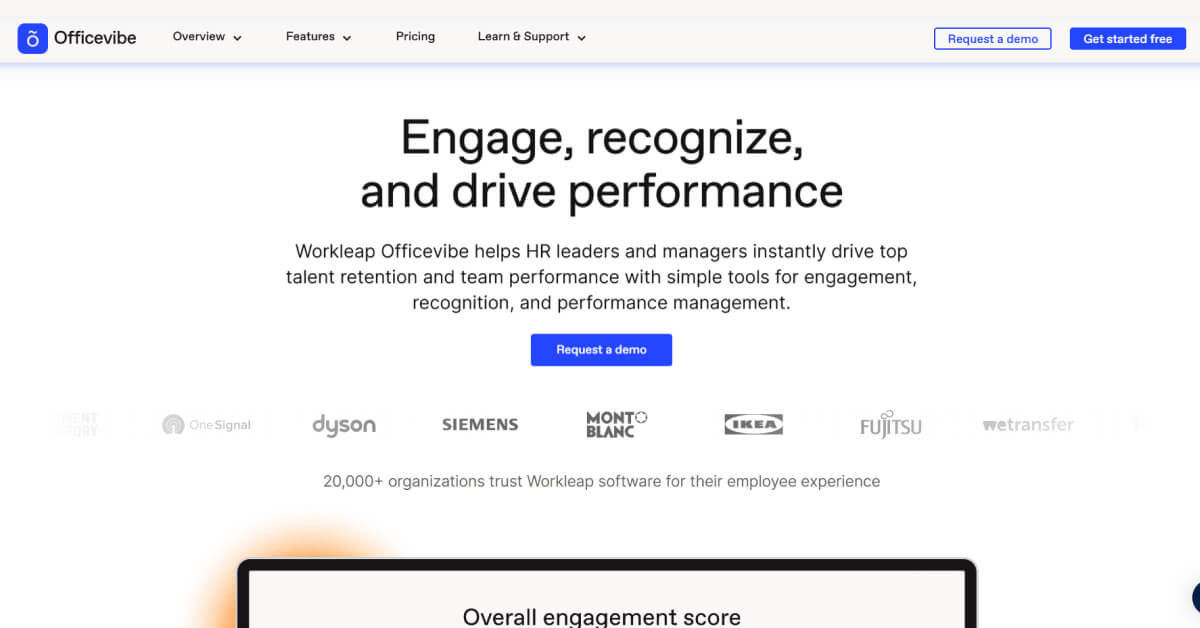
- Pulse surveys for continuous insights: Officevibe empowers organizations to capture the heartbeat of their culture through regular pulse surveys. These bite-sized, real-time assessments provide continuous insights, ensuring that organizations stay agile and responsive to evolving employee needs.
- Actionable feedback: Beyond data collection, Officevibe focuses on driving action. It not only identifies areas for improvement but also provides actionable recommendations to help organizations address issues and bolster strengths.
- Employee well-being: Officevibe places a strong emphasis on employee well-being. It gauges factors like stress, workload, and healthy work-life balance, enabling organizations to create a supportive environment that fosters physical and mental health.
- Integration and analytics: Seamlessly integrating with popular collaboration tools like Slack and Microsoft Teams, Officevibe ensures that collecting feedback is frictionless. It also offers robust analytics and reporting tools.
4. Qualtrics XM
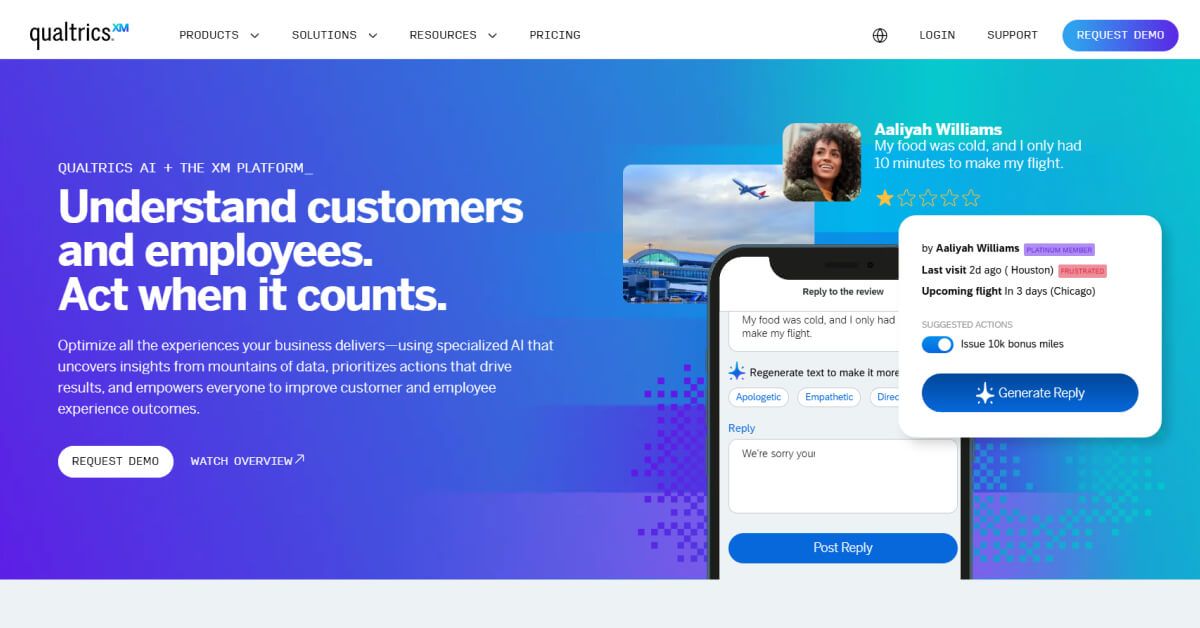
- Tailored culture surveys: Qualtrics XM offers unparalleled flexibility in crafting culture surveys. Tailor your assessments to align precisely with your organization's unique goals, from measuring employee engagement to tracking the impact of culture-enhancing initiatives.
- 360-Degree insights: Beyond employee surveys, Qualtrics XM takes a holistic approach. It leverages feedback from employees, customers, and other stakeholders to provide a comprehensive view of your organization's culture and its impact on business outcomes.
- Powerful analytics: Dive deep into culture analytics with Qualtrics XM's advanced reporting tools. Uncover hidden trends, benchmark against industry standards, and gain a competitive edge by making data-driven decisions.
- Real-time action plans: Qualtrics XM doesn't just stop at measurement—it excels in driving change. Transform feedback into actionable strategies with personalized action plans, ensuring that your organization not only understands its culture but actively shapes it for success.
5. TINYpulse
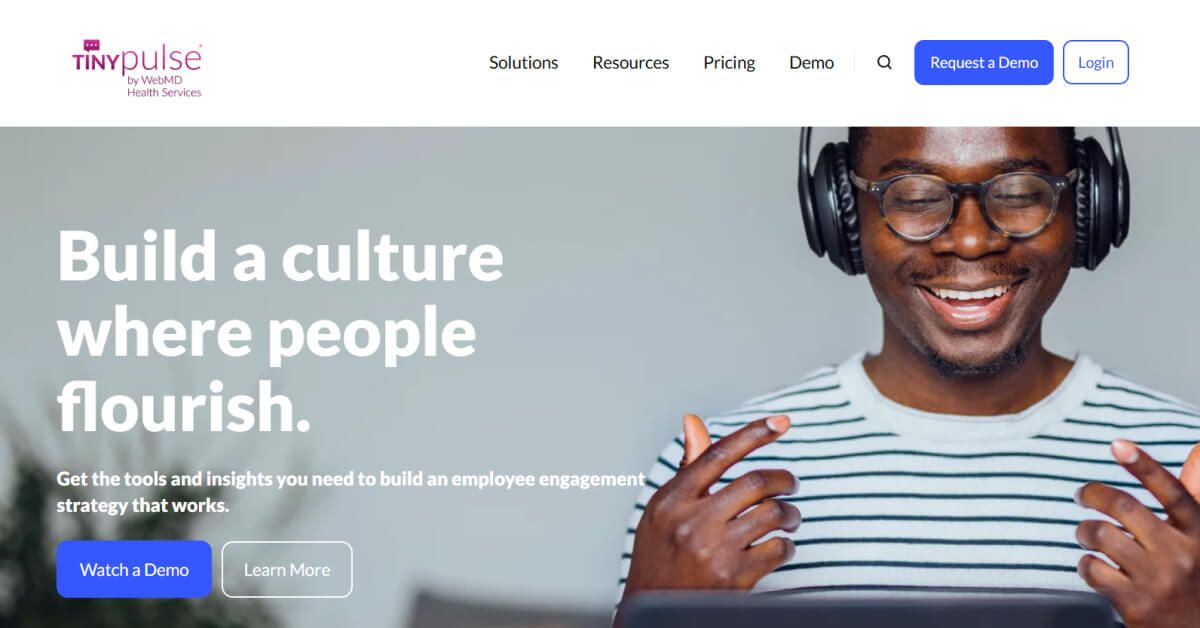
- Pulse surveys for real-time insights: TINYpulse empowers organizations to capture real-time feedback through pulse surveys. These short, frequent check-ins provide continuous insights, ensuring that organizations stay agile and responsive to evolving employee needs.
- Peer recognition with cheers: TINYpulse fosters a culture of appreciation with its Cheers feature, allowing employees to recognize and celebrate each other's contributions. This promotes a positive and inclusive workplace culture.
- Actionable feedback: Beyond data collection, TINYpulse is committed to driving actionable change. It doesn't just identify areas for improvement but provides actionable recommendations to help organizations address issues and strengthen their culture.
- TINYhr insights and analytics: TINYpulse offers a robust analytics suite with TINYhr Insights. Dive deep into culture analytics, uncover trends, and make informed decisions based on comprehensive data.
Conclusion
A workplace culture survey is a critical tool for understanding how aligned your organizational values are with employee experiences. It helps identify areas that need improvement and reinforces aspects that are working well, ultimately contributing to a more inclusive and motivated workforce.
By regularly conducting culture surveys, organizations can ensure they are fostering a positive work environment that promotes engagement, collaboration, and satisfaction. CultureMonkey allows businesses to gather real-time data efficiently, empowering leaders to respond to employee concerns quickly.
Its pulse survey tool offers real-time insights, enabling businesses to track employee sentiment continuously. With anonymous feedback features, CultureMonkey allows businesses to gather real-time data efficiently, empowering leaders to respond to employee concerns quickly.
Visit CultureMonkey today to get started on your journey.
Summary
A workplace culture survey is a tool for assessing an organization’s core values, behaviors, and employee experiences. By gathering insights on communication, leadership, collaboration, and inclusivity, companies can identify gaps between their ideal culture and reality. Effective surveys help organizations improve employee engagement, align values, and foster a positive work environment.
Regular assessments and acting on the results lead to stronger workplace culture, better productivity, and higher employee retention. CultureMonkey provides a streamlined platform for conducting such surveys, ensuring actionable insights.
FAQs
1. Why should a company conduct a work culture survey?
A company should conduct a work culture survey to gain insights into the employee experience and identify areas for improvement. It helps in understanding employee satisfaction, engagement, and perceptions of the workplace environment. By addressing the feedback received, companies can foster a positive culture, boost productivity, and reduce turnover, ultimately leading to a more cohesive and motivated workforce.
2. What is the purpose of a culture survey?
A culture survey aims to gauge employees' perceptions, attitudes, and experiences within the organization. It helps identify strengths, weaknesses, and areas for improvement in the organizational culture. By understanding employee perspectives, organizations can foster a sense of belonging, improve employee engagement, and align cultural initiatives with employee needs and values.
3. How often should organizations conduct organizational culture surveys?
Organizations should conduct culture surveys regularly to track changes in the cultural climate and address emerging issues. While the frequency may vary depending on organizational needs and resources, conducting surveys annually or biennially is common practice. Regular surveys ensure that organizations stay informed about employee sentiments and can proactively address cultural challenges.
4. How do organizational culture surveys differ from other types of employee surveys?
Organizational culture surveys focus specifically on assessing the cultural climate and values within the organization. Unlike other employee surveys that may cover a range of topics such as job satisfaction, benefits, or performance feedback, culture surveys delve deeper into employees' perceptions of the organization's values, norms, and overall cultural environment.
5. How does remote work or distributed teams impact the effectiveness of organizational culture surveys?
Remote work and distributed teams can pose challenges to the effectiveness of organizational culture surveys. Communication barriers, lack of face-to-face interaction, and feelings of isolation may affect employees' perceptions of the organizational culture. To address these challenges, organizations can adapt culture surveys to include questions specifically tailored to remote work experiences, foster virtual team-building activities, and prioritize communication and transparency to maintain a strong sense of employee belonging and connection.
6. How can employee participation in a work culture survey be increased?
To increase employee participation in a work culture survey, ensure anonymity and confidentiality to make employees feel safe sharing honest feedback. Communicate the importance and benefits of the survey clearly. Provide convenient access and enough time to complete the survey. Additionally, demonstrate commitment to acting on the feedback by sharing results and outlining planned improvements, thus building trust and encouraging participation.
7. What is an example of a culture assessment in the workplace?
A culture assessment evaluates how well an organization’s values align with employee experiences. For instance, a tech company may use anonymous surveys and focus groups to assess inclusivity, leadership effectiveness, and communication gaps. Insights from these assessments guide initiatives like mentorship programs or flexible work policies to enhance employee engagement and strengthen company culture.





